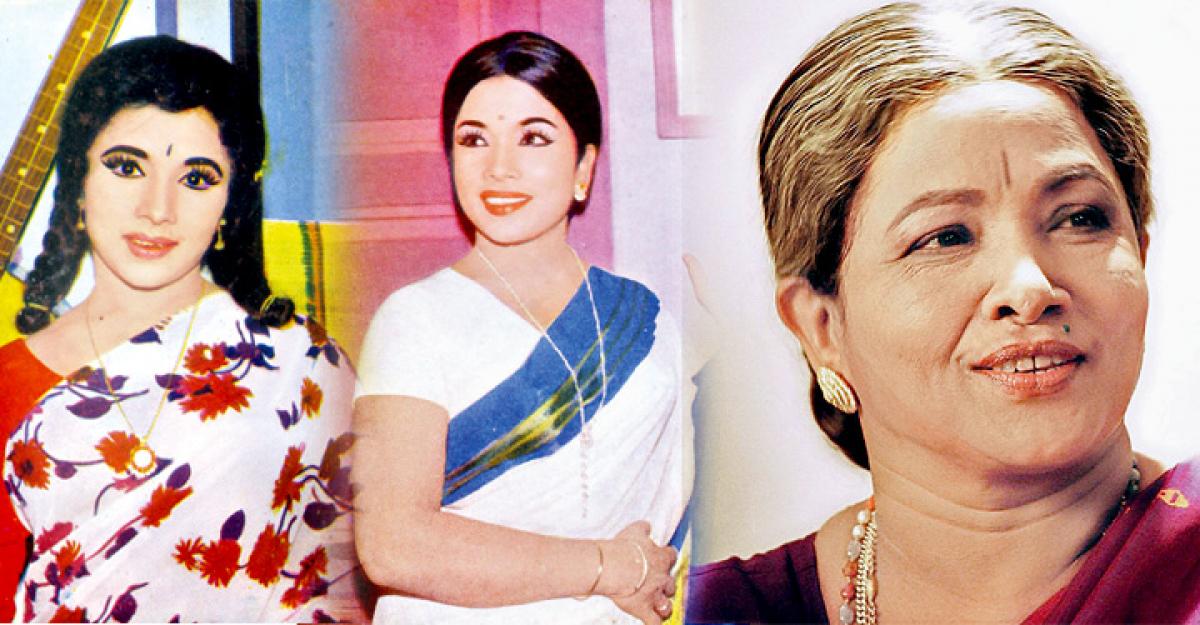The long-lasting star, who shone all through

Gopishantha, better known as Manorama, breathed her last on October 10 leaving a great legacy behind. The heroine-turned-character actress had no peers in the manner with which she stayed afloat, generation after generation, performing..
Gopishantha, better known as Manorama, breathed her last on October 10 leaving a great legacy behind. The heroine-turned-character actress had no peers in the manner with which she stayed afloat, generation after generation, performing with her trademark gusto in multi-lingual films from native Tamil to Telugu to Malayalam, and an occasional exposure in Hindi.
.jpg) In an era where career spans alter from one Friday to another for cine stars from any film industry, it is astonishing in a way that a plain-looking yet multi-talented lady film artiste managed to last actively for more than five decades, acting in 1,500 films in all! Heroes there have been, even comedians, who have stayed longer than they were expected to be, but senior stars, who have often involuntarily retired from the celluloid world had one exception in her case, for sure.
In an era where career spans alter from one Friday to another for cine stars from any film industry, it is astonishing in a way that a plain-looking yet multi-talented lady film artiste managed to last actively for more than five decades, acting in 1,500 films in all! Heroes there have been, even comedians, who have stayed longer than they were expected to be, but senior stars, who have often involuntarily retired from the celluloid world had one exception in her case, for sure.
Gopishantha, known better by her name Manorama, is the heroine-turned-character actress, who has managed this amazing feat. With a film ‘Malaiyitta Mangai’, she began her career as the leading lady, a good 57 years ago in 1958. Till she faded away from the scene after a cameo presence in the Suriya-starrer Singam II two years ago, she had no peers in the manner with which she stayed afloat, generation after generation, performing with her trademark gusto in multi-lingual films from native Tamil to Telugu to Malayalam and an occasional exposure in Hindi.
Accolades have been many, awards have been considerable and her co-stars, be it a comedian or a performer with a defined histrionic dimension, have all vouched for her intense talent when it comes to living the roles that she was featured for in films. No wonder she was the ‘Nadigayar Thilagam’, (The epitome of acting, a loose translation) the female version of Sivaji Ganesan, popular for his adage ‘Nadigar Thilagam’, for his bombastic dialogue delivery and screen presence. Interesting that this encomium was vested on her, rather than the bevy of beauties, who sauntered across the filmi landscape of the industry all these years!
 It is an absolute case study of sorts for lovers of Indian cinema as to how longevity is possible in a sphere of business, which worships immediacy and constantly looks for new faces and talent. Manorama, by and large, transited through the changing trends and directions of southern cinema very well. Primarily because, she acted her age over the time that she spent time under the arc lights, playing the counterfoil to her fellow artistes and managing to hold on her own, even when the later lot, who were junior in age and experience, replaced her old batchmates. The strong grounding in theatre, a popular training ground for the then emerging motion picture industry of the post-Independence era was a definite plus in her case.
It is an absolute case study of sorts for lovers of Indian cinema as to how longevity is possible in a sphere of business, which worships immediacy and constantly looks for new faces and talent. Manorama, by and large, transited through the changing trends and directions of southern cinema very well. Primarily because, she acted her age over the time that she spent time under the arc lights, playing the counterfoil to her fellow artistes and managing to hold on her own, even when the later lot, who were junior in age and experience, replaced her old batchmates. The strong grounding in theatre, a popular training ground for the then emerging motion picture industry of the post-Independence era was a definite plus in her case.
If it was Nagesh and Cho Ramaswamy among others, who were her buffooning co-stars in the black-and-white era up till the ‘80s, the new era of directors, who had separate comedy tracks with their own stars and dialogue writers still had slots, which only she could fill. An entire range of stars in Tamil cinema and to a limited extent in Telugu had shared screen space with her as she essayed a mix of roles – a sister, a mother and the comedienne, who could independently tickle the funny bone of the discerning viewer.
Assured of her craft and the unique manner in which the industry operates, Manorama co-acted with her erstwhile stars and their progenies, who had grown up seeing her on screen and off it in social circles. Despite inducing a humorous mood for sure with her antics, she had to grapple with a failed marriage and a doomed filmi career of her son Bhoopathy, who was lost to the vices of the world for a long time, as the mother slogged to run the show at home.
Films, there are, far too many and many of them, right from the time when she was an up and coming star, which were re-made into other languages from Tamil, where she left behind a stamp of class. This probably did not give her the pan-Indian publicity that she richly deserved. Back home, one example of her award-winning performance was in the 1989 release ‘Pudhiya Paadhai’ (New Route), which was the launch pad of its hero R Parthiban, a directorial assistant of the famous director K Bhagyaraj. This film also bagged the National Award for the Best Feature Film in Tamil during the same year, which moved the spotlight from her as the new hero went on to carve out a noticeable career in Tamil cinema.
All the same, despite a scrap with Rajinikanth on a sensitive political situation in which the superstar was enmeshed in, her goodwill with the fraternity made the scenario ease out gradually in her favour over time. This, if it was any other cine personality, would have been counterproductive. Manorama managed such twists and turns very well and as she sailed away into another world and time on October 10, one can surely conclude she was the dark horse who rode for the longest time possible in the southern film industry.
She did Telugu films too….
The versatility of Manorama was on display in Telugu cinema too, even as her fame had already made its way earlier with her dubbed films and those which were remade.Beginning with the 1980 release ‘Subhodhayam’, directed by legendary K Viswanath in which Charu Haasan, the elder brother of Kamal Haasan too essayed a role. She did half-a-dozen Malayalam films too over the next decade and more, till ‘Rikshavodu’ happened in 1996, when she played granny to Chiranjeevi in the film, with her presence adding value to the double role enacted by the megastar.
Five years later, she was seen in Nagarjuna’s ‘Bava Nachadu’ and like her earlier release, this one too failed to woo the viewers. The third one in which she once again was selected for a role – ‘Krishnarjuna’ released in 2008 too crashed at the box office. It was Anushka’s ‘Arundhati’ released in 2009 that came to her help by ending the drought of flops at the box office and turned out to be a winner. None of these films however dented her reputation as a multi-faceted cine star who could act and croon if the need arose in her films like the old generation contemporaries like Dr. Bhanumathi Ramakrishna.
By K Naresh Kumar








